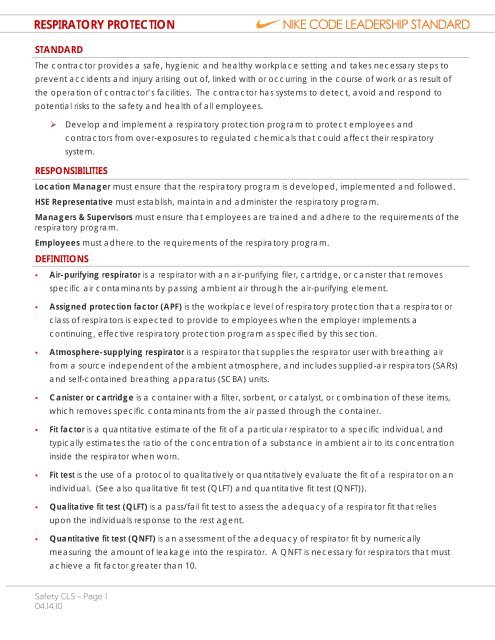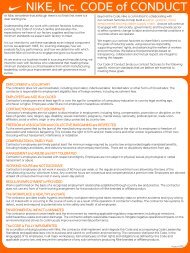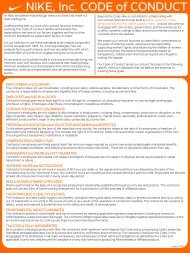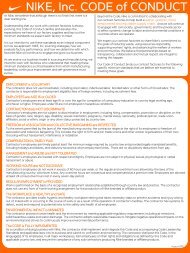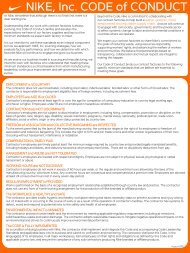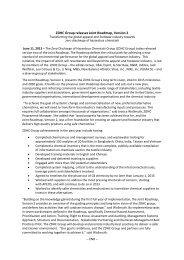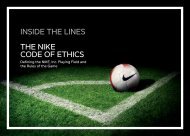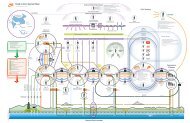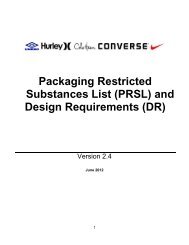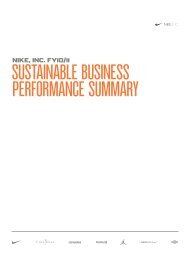COC CLS - Healthy Safety Environment - NIKE, Inc. - The Journey
COC CLS - Healthy Safety Environment - NIKE, Inc. - The Journey
COC CLS - Healthy Safety Environment - NIKE, Inc. - The Journey
You also want an ePaper? Increase the reach of your titles
YUMPU automatically turns print PDFs into web optimized ePapers that Google loves.
RESPIRATORY PROTECTION<br />
STANDARD<br />
<strong>The</strong> contractor provides a safe, hygienic and healthy workplace setting and takes necessary steps to<br />
prevent accidents and injury arising out of, linked with or occurring in the course of work or as result of<br />
the operation of contractor’s facilities. <strong>The</strong> contractor has systems to detect, avoid and respond to<br />
potential risks to the safety and health of all employees.<br />
‣ Develop and implement a respiratory protection program to protect employees and<br />
contractors from over-exposures to regulated chemicals that could affect their respiratory<br />
system.<br />
RESPONSIBILITIES<br />
Location Manager must ensure that the respiratory program is developed, implemented and followed.<br />
HSE Representative must establish, maintain and administer the respiratory program.<br />
Managers & Supervisors must ensure that employees are trained and adhere to the requirements of the<br />
respiratory program.<br />
Employees must adhere to the requirements of the respiratory program.<br />
DEFINITIONS<br />
• Air-purifying respirator is a respirator with an air-purifying filer, cartridge, or canister that removes<br />
specific air contaminants by passing ambient air through the air-purifying element.<br />
• Assigned protection factor (APF) is the workplace level of respiratory protection that a respirator or<br />
class of respirators is expected to provide to employees when the employer implements a<br />
continuing, effective respiratory protection program as specified by this section.<br />
• Atmosphere-supplying respirator is a respirator that supplies the respirator user with breathing air<br />
from a source independent of the ambient atmosphere, and includes supplied-air respirators (SARs)<br />
and self-contained breathing apparatus (SCBA) units.<br />
• Canister or cartridge is a container with a filter, sorbent, or catalyst, or combination of these items,<br />
which removes specific contaminants from the air passed through the container.<br />
• Fit factor is a quantitative estimate of the fit of a particular respirator to a specific individual, and<br />
typically estimates the ratio of the concentration of a substance in ambient air to its concentration<br />
inside the respirator when worn.<br />
• Fit test is the use of a protocol to qualitatively or quantitatively evaluate the fit of a respirator on an<br />
individual. (See also qualitative fit test (QLFT) and quantitative fit test (QNFT)).<br />
• Qualitative fit test (QLFT) is a pass/fail fit test to assess the adequacy of a respirator fit that relies<br />
upon the individuals response to the rest agent.<br />
• Quantitative fit test (QNFT) is an assessment of the adequacy of respirator fit by numerically<br />
measuring the amount of leakage into the respirator. A QNFT is necessary for respirators that must<br />
achieve a fit factor greater than 10.<br />
<strong>Safety</strong> <strong>CLS</strong> – Page 1<br />
04.14.10


